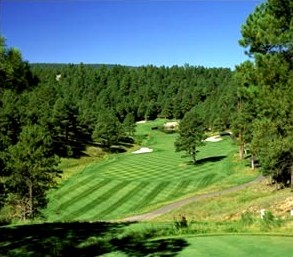
Arizona Golf Authority AZGA Buzz: There’s a good reason national magazines rank Forest Highlands’ Canyon Course as one of the best courses in Arizona every year. When it comes to top quality golf, it simply doesn’t get any better than the Canyon Course – and the club’s other course, Meadow, is northern Arizona ponderosa pine forest perfection as well.
The Canyon Course, designed by then-partners Tom Weiskopf and Jay Morrish, was created in 1988 as part of a 1,100-acre enclave in the midst of majestic pine trees and groves of matures oaks and aspens in the cool forests of northern Arizona at 7,200-feet of elevation. As beautiful and serene as the Canyon’s setting is, it presented something of a design challenge, with Morrish fearing that the topography lent itself to too many driver-and-wedge par-4 holes, so he and Weiskopf folded, spindled and mutilated the lineup card and produced a revolutionary new batting order.
Far from the norm, they created a unique combination of six par-3 holes, five par-5s and seven par-4s; the back nine has three of each. The routing works so well that many golfers don’t notice that every other hole between the fourth and 14th is a par-3.
That all translates to a par-71 challenge, with four sets of tees at 7,007, 6,647, 6,225 and 5,004 yards. From the tips, it is rated at an over-par 72.6 with a stern slope of 139.
This course has hosted the U.S. Mid-Amateur and Junior Amateur, Canon Cup and numerous other USGA and Arizona Golf Association events.

Gorgeous canyon vistas, free-flowing streams and upwardly sweeping walls of Ponderosa pines frame the layout that is loaded with memorable holes, including the par-3 fourth, considered the signature hole, which plays across a lake at 182 yards with a second smaller pond, up at green level, guarding the front-left side of the green; the waterfall tells you it’s there. Two pine trees pinch access from the front-right of the green so the baby-draw the hole sets up for must be precisely flighted.
Our vote is cast for the ninth, though. The par-4 plays at 466 yards, starting on a wildflower-covered hillside, with a tee shot that hangs in the air for several seconds before landing in a low-lying meadow defined by a mountainside brook, which bisects the fairway near the landing area and spills into a pond along the right side of the green, part of a large green complex shared with the eighteenth. Your approach shot must carry the pond to the elevated green; bunkers right and left look appealing when compared to “short, in the pond”. Tricky green, stunning setting; fun golf hole.
Another standout par-3 is the 165-yard 14th, which offers no option except an accurate, full-carry over a lake protecting the front and complete right side of a deep, but quite narrow, green. Once on the dance floor, you will find an undulating putting surface that mimics the surface of an angry body of water, captured and reproduced in bent grass; you won’t find a flat putt here.
When it opened for play in 1988, the Canyon Course was ranked in second position by Golf Digest on their list of the best new golf courses in the country, just behind Shadow Glen in Kansas City, which also was also designed by Weiskopf and Morrish. That layout has faded from the rankings while Forest Highlands’ Canyon Course has stood the test of time.
Snagging a tee time is the tough part because this is an exclusive, equity club. Membership to both courses comes with property ownership, although in recent years, Forest Highlands has sold a limited number of “special memberships.” Each course has its own clubhouse and championship caliber practice facilities. The Canyon clubhouse presents an elegant, traditional look and serves as the gated community’s social center with fine dining, a lounge, locker rooms and administrative offices.
Read the Arizona Golf Authority AZGA Buzz for Forest Highlands’ Meadow Course.
